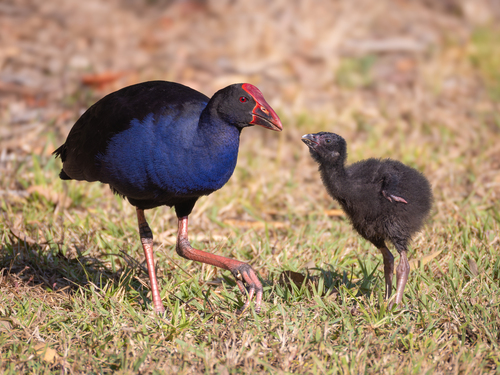
Australasian Swamphen
The Australasian Swamphen (Porphyrio porphyrio melanotus) is a large, striking bird found across Australia, New Zealand, eastern Indonesia, and Papua New Guinea. It's a member of the rail family, known for its vibrant plumage and robust build. Often seen in wetlands, swamps, and grasslands, this bird plays an important ecological role in controlling vegetation and serving as prey for larger predators. It is also culturally significant to some Indigenous groups, featuring in stories and traditions.
44-54 cm
Length
75-90 cm
Wingspan
Least Concern
Conservation Status
Distribution
Eastern Indonesia, Papua New Guinea, Australia, and New Zealand. It is found in various altitudes, from sea level up to higher elevations in suitable wetland habitats.
Lifespan
Up to 10 years in the wild; longer in captivity.
Australasian Swamphen's Habitat
Habitat Types
Wetlands, Swamps, Marshes, Lakeshores, Grasslands near water, Reed beds
Climate Zones
Tropical, Subtropical, Temperate
Adaptations
Large feet for walking on floating vegetation; strong legs for navigating dense reeds; able to swim, though not as adept as specialized waterbirds.
Variations
Several subspecies exist, with *P. p. melanotus* being the most common in the Australasian region. Variations primarily involve subtle differences in size and plumage coloration.
Appearance
Breeding Plumage
Minimal seasonal variation.
Seasonal Feather Changes
Little to none.
Sex Based Plumage Differences
Minimal; males and females have similar plumage.
Notable Features
Large, red frontal shield, Deep blue-purple plumage, Black upperparts and head, White undertail coverts, Red bill and legs
Diet and Feeding
Primary Foods
Shoots, Stems, Leaves of aquatic plants, Seeds, Insects, Small invertebrates, Occasionally frogs and eggs
Foraging Behavior
Forages by walking and wading in shallow water, picking at vegetation and probing mud with its bill. It also uses its feet to grasp and manipulate food.
Specializations
Strong bill adapted for tearing and pulling vegetation.
Seasonal Diet Variations
May consume more invertebrates during breeding season to provide protein for chicks.
Behavior
Social Structure
Often found in pairs or small family groups, but can form larger flocks outside of breeding season.
Communication
Loud, raucous calls, Squawks, Visual displays (e.g., flicking tail to expose white undertail coverts)
Migration
Generally sedentary, but may undertake local movements in response to water availability.
Territorial or Group Behaviors
Territorial during breeding season, defending nesting sites. Can be aggressive towards intruders.
Conservation
Threats
Habitat loss and degradation (due to drainage and development), Predation by introduced species (e.g., foxes, cats), Hunting (in some areas)
Protection Programs
Wetland conservation and restoration efforts, Predator control programs in some areas
Local National Laws
Protected under wildlife legislation in many parts of its range.
Population Trend
Stable
Population Estimates
Difficult to estimate precisely due to its wide distribution and often secretive nature; considered widespread and relatively common.
Interesting Facts
They are known for their strong legs and feet.
They use their feet to hold and manipulate food, a trait not common in many bird species.
They are capable swimmers.
Although primarily found wading, they can swim when necessary, especially to escape predators.
Their chicks are precocial
Chicks can walk and swim shortly after hatching.
Faqs about Australasian Swamphen
Are Australasian Swamphens aggressive?
They can be territorial, especially during breeding season, and may defend their nesting areas aggressively.
What is the red shield on their head for?
The frontal shield is believed to play a role in social signaling and display, particularly during courtship and territorial disputes.
Can Australasian Swamphens fly?
Yes, they can fly, although they often prefer to walk or run. They are not strong fliers and typically fly short distances.
Copyright @ Nature Style Limited. All Rights Reserved.
 English
English